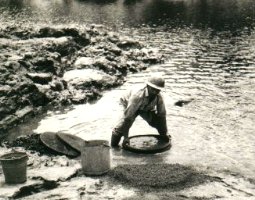


You may have wondered where the strange name Coromoto Minerals derives. Here is the abbreviated story.
My father, an avid treasurer seeker, spent the ‘60s in Venezuela. He was working there as part of the development of the huge iron ore deposits in the state of Bolivar. I can remember well when my family first joined him there after his 1st 3 months on the job. We flew into Miquetia from the US. Our flight into the interior was not until the next day.. When we arrived at our hotel that evening, my father ushered us all into my parents room. After closing the drapes and carefully checking that the coast was clear, he dumped onto the bed a glistening pile of crystals. "DIAMONDS" he whispered. We had a lot to learn! They were indeed nice quartz crystals that he had picked up off of the bank of the Orinoco river at Puerto Ordaz, now Ciudad Guayana. Unfortunately not the trove he had imagined.
Living for a year at the Gran Hotel Bolivar, in Ciudad Bolivar, we met a stream of adventurers who would come up out of the bush for a little r&r and just plain hell raising. Characters such as Dick West and the ‘Dutchman’ regaled us with stories of the riches being screened out of the newly discovered ancient Caroni river bed. We saw mayonnaise jars filled with diamonds of all colors. There was little doubt that these were the real thing. We did, in fact, eventually go on to find a few diamonds in the Caroni river ourselves.



Later we moved to Ciudad Piar a little mine town
at the base of Cerro Bolivar. At Piar we were substantially closer to the
diamond d
grounds. We spent may weekends during the annual dry season screening the
alluvial material from the holes that had been augured into the bottom
of the river be. Much like gold, diamonds work their way to the lowest
point in these naturally carved pits because of their high density. My
job, being the smallest one on our crew, was to wiggle my way into these
cavities and bring up the material from the bottom. Then either my father
of Vivalo, our Italian gardener and partner, would screen the material.
Every once in awhile our efforts would be rewarded with a diamond. Not
many really -but a lot of fun. After a while the word was out that the
loco gringo Americano would grubstake practically anyone who showed up
at the door. My dad provisioned many a hopeful. Unfortunately no one ever
returned with the ‘big one’ or even returned for that matter.
d
grounds. We spent may weekends during the annual dry season screening the
alluvial material from the holes that had been augured into the bottom
of the river be. Much like gold, diamonds work their way to the lowest
point in these naturally carved pits because of their high density. My
job, being the smallest one on our crew, was to wiggle my way into these
cavities and bring up the material from the bottom. Then either my father
of Vivalo, our Italian gardener and partner, would screen the material.
Every once in awhile our efforts would be rewarded with a diamond. Not
many really -but a lot of fun. After a while the word was out that the
loco gringo Americano would grubstake practically anyone who showed up
at the door. My dad provisioned many a hopeful. Unfortunately no one ever
returned with the ‘big one’ or even returned for that matter.
Piar was the last outpost south. The paved road from Ciudad Bolivar ended here. Wandering around on the Gran Savanna my father stumbled onto or was shown an abandoned Spanish gold mine from the 1700’s. This old workings was just 40 km from Angels falls and in sight of towering tepui’s. Along with an old salt named Anderson, a claim was filed and the ‘new mine’ christened Santa Coromoto.
The Spanish no doubt with the 'assistance' of the locals Indians sank 3 or 4 vertical shafts into a hilltop. The ore was rich enough to have visible gold. Unfortunately, when properly surveyed, the estimate then in 1962 was that the price of gold would have to be $135/ounce for the operation to be viable. At that time though gold was fixed at $35/ounce. So Coromoto was just another one of those dreams. But as they say the apple doesn't fall far from the tree. My father would be thrilled to dig at the Orchard Pit and I would be thrilled to have him. Thank you, Dad.


Back
to Coromotominerals Hompage
1999
and 2000 gem discoveries in
Oxford
County Maine